
The Canadian video game industry involves the development, marketing, and monetization of video games in Canada. This industry overview will discuss the latest statistics and trends for the video game industry in Canada. For more information on the video game industry please see our Video Game Industry Guide.
Photo credit: Photo by Alexas_Fotos
Key Takeaways
- Thriving industry: Canada’s video game industry contributed $3.7 billion to the economy in 2017 (Nordicity, 2017).
- Export-driven industry: Exports accounted for 75% of industry revenue in 2017 (Nordicity, 2017).
- Nation of gamers: 61% of the national population currently identifies as video gamers (ESAC, 2018).
- Shifting demographics: 39 is the average age of Canadian video gamers, with 50% being male, and 50% being female (ESAC, 2018).
- Consumer preferences: 46% of Canadians prefer to play video games most often on their mobile devices (ESAC, 2018).
Industry Performance Snapshot
- Total revenue among video game companies in Canada was $3.2 billion in 2017, while total expenditure was $2.6 billion (ESAC, 2017).
- In 2017, exports accounted for 75% of all revenue generated by video game companies in Canada. The US and Europe were the top sources of export revenue at 46% and 42% respectively (Nordicity, 2017).
- During 2015-2017, total GDP generated by the Canadian video game industry increased by 24% to just over $3.7 billion (Nordicity, 2017).
Industry Output
- About 2,100 video game projects were completed in 2017, with web (31%) and mobile platforms (29%) accounting for the largest proportions (Nordicity, 2017).
- Family-oriented games were the most popular genre in 2017, accounting for 26% of all video game projects completed that year (Nordicity, 2017).
- Budgets for console projects decreased by 26% to $12.5 million in 2017. Despite this, console games still accounted for 89% of all production spending (Nordicity, 2017).
Cost Breakdown
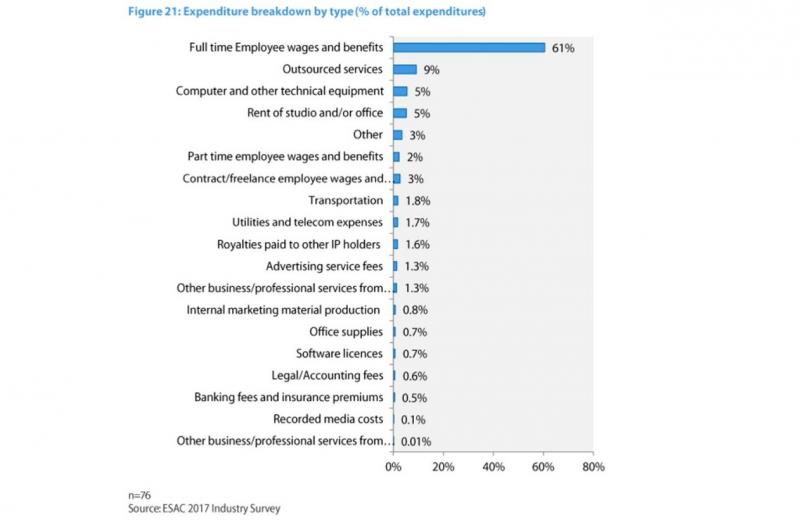
Source: Nordicity. (2017). Canada’s Video Game Industry in 2017 – Final Report. Retrieved from: http://theesa.ca/wp-content/uploads/2017/11/ESAC-Video-Games-in-Canada-Profile-2017_FINAL.pdf
Consumer Spending
Between July 2017 and June 2018, Canadians spent a total of $8.1 billion on digital products. Online gaming subscriptions, game downloads, and in-game purchases accounted for 16.7% of overall spending. Consumers between the ages of 25-34 were the largest group of spenders. This group accounted for about 35% of total spending or $471 million.
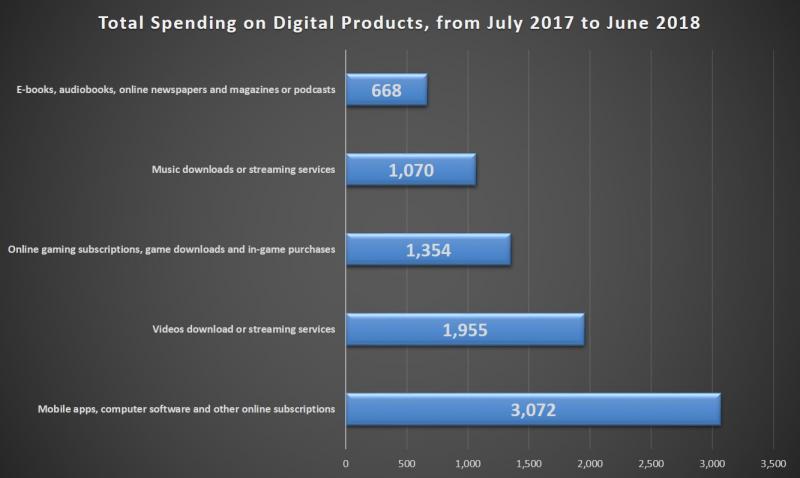
Source: Statistics Canada. Table 3: Total Spending on Digital Products, from July 2017 to June 2018. Retrieved from: https://www150.statcan.gc.ca/n1/daily-quotidien/180829/t003b-eng.htm
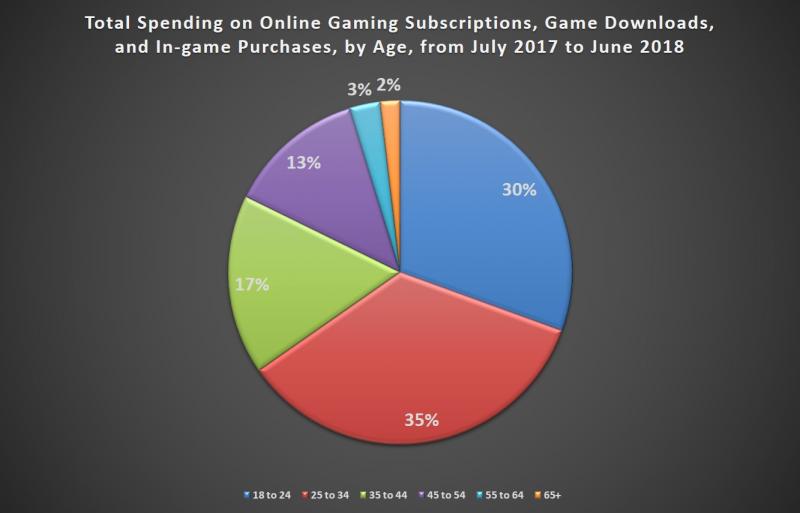
Source: Statistics Canada. Table 3: Total Spending on Digital Products, from July 2017 to June 2018. Retrieved from: https://www150.statcan.gc.ca/n1/daily-quotidien/180829/t003b-eng.htm
Business Locations
As the following chart illustrates, the majority of Canada’s video game companies are located in three provinces: Quebec, Ontario, and British Columbia. This has remained consistent since 2013.
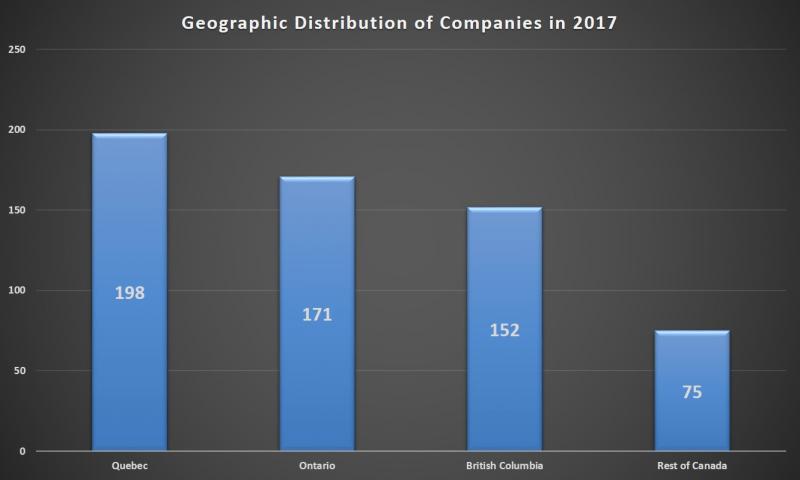
Source: Nordicity. (2017). Canada’s Video Game Industry in 2017 – Final Report. Retrieved from: http://theesa.ca/wp-content/uploads/2017/11/ESAC-Video-Games-in-Canada-Profile-2017_FINAL.pdf
Employment Statistics
In 2017, the Canadian video game industry directly employed 21,800 employees. Quebec was Canada’s top employer with 10,000 employees or 45.9%% of the total number of employees in Canada’s video game industry in 2017.
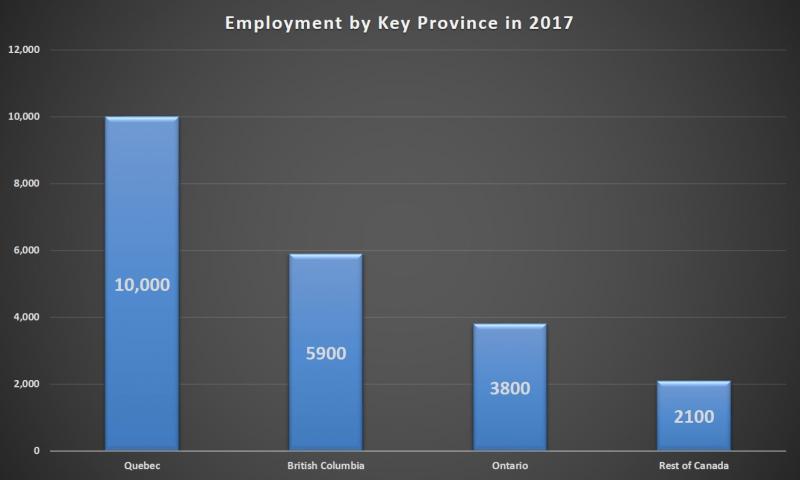
Source: Nordicity. (2017). Canada’s Video Game Industry in 2017 – Final Report. Retrieved from: http://theesa.ca/wp-content/uploads/2017/11/ESAC-Video-Games-in-Canada-Profile-2017_FINAL.pdf
Trends and Changes
Changing demographics
- The average age of Canadian video gamers is on the rise. The average Canadian video gamer was 39 years of age in 2018 (ESAC, 2018), compared to 36 in 2017 (ESAC, 2017).
- The number of female gamers is on the rise. In 2018, 50% of Canadian video gamers were female (ESAC, 2018), compared with 49% in 2017 (ESAC, 2017).
Parents as gamers
- Canadian parents are not only purchases of video games, but also active consumers of them. 71% of parents played video games with their children (ESAC, 2018) in 2018, compared with 68% of parents in 2016 (ESAC, 2016).
Popularity of mobile gaming
- 46% of Canadians played video games most often on their mobile devices in 2018 (ESAC, 2018), compared to 41% in 2016 (ESAC, 2016).
- Although more Canadians are playing video games on their mobile devices, the market for computers and consoles still remains strong (see below).
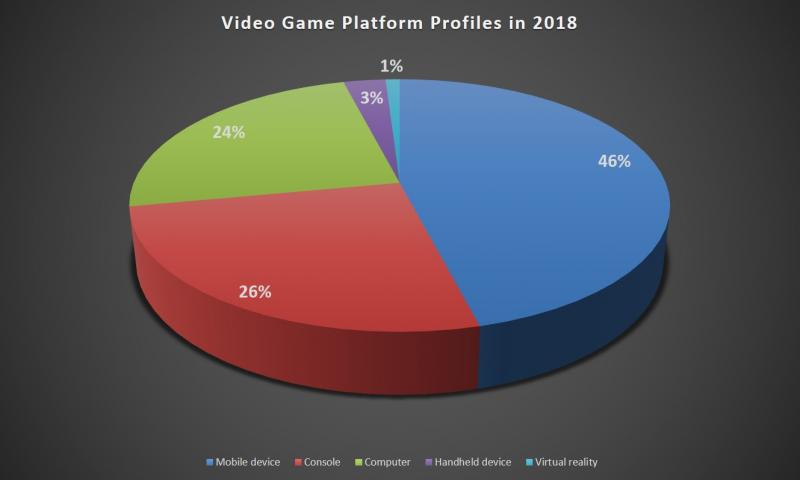
Source: ESAC. (2018). Essential Facts about the Canadian Video Game Industry. Retrieved from: http://theesa.ca/wp-content/uploads/2018/10/ESAC18_BookletEN.pdf
Emergence of Virtual Reality (VR) gaming
- The Canadian game industry is accelerating production of VR games, with companies reporting over 250 new VR projects in 2016 alone (Nordicity, 2017).
- As of 2018, 8% of Canadians already own a VR system (ESAC, 2018).
Social gaming as a global trend
- Since 2017, social/casual gaming revenue has overtaken traditional gaming revenue to become the largest component of the video games market (PwC, Entertainment & Media Outlook, n.d.)
- In Canada, social or casual games are stills the fastest growing area of the video games market. Since 2015, they have made up over 50% of Canada’s total video games revenue (PwC, Entertainment & Media Outlook, n.d.).
- Online, free-to-play, battle royale games such as Fortnite are at the forefront of the social gaming trends. More video game publishers will likely try and emulate Fortnite’s business model to remain competitive (PwC, Entertainment & Media Outlook, n.d.).
Sources
ESAC. (2018). Essential Facts about the Canadian Video Game Industry 2018. Retrieved from: http://theesa.ca/wp-content/uploads/2018/10/ESAC18_BookletEN.pdf
ESAC. (2017). Essential Facts about the Canadian Video Game Industry 2017. Retrieved from: http://theesa.ca/wp-content/uploads/2017/10/ESAC2017_Booklet_13_Digital.pdf
ESAC. (2016). Essential Facts about the Canadian Video Game Industry 2016. Retrieved from:
http://theesa.ca/wp-content/uploads/2016/11/2016_booklet_Web.compressed2.pdf
Nordicity. (2017). Canada’s Video Game Industry in 2017 – Final Report. Retrieved from: http://theesa.ca/wp-content/uploads/2017/11/ESAC-Video-Games-in-Canada-Profile-2017_FINAL.pdf
PwC. (n.d.). Entertainment & Media Outlook 2019-2023. Retrieved from: https://www.pwc.com/ca/en/industries/entertainment-media/outlook-2019-2023.html
Statistics Canada. (n.d.). Table 3: Total Spending on Digital Products, from July 2017 to June 2018. Retrieved from: https://www150.statcan.gc.ca/n1/daily-quotidien/180829/t003b-eng.htm



